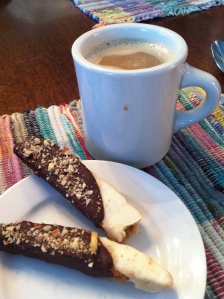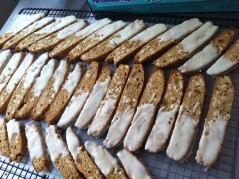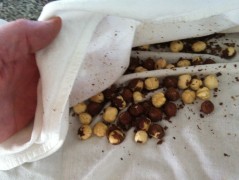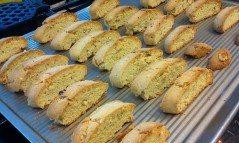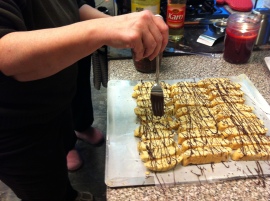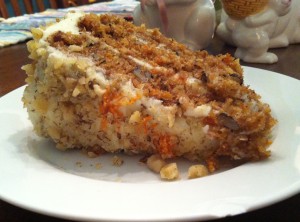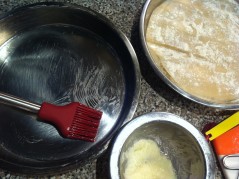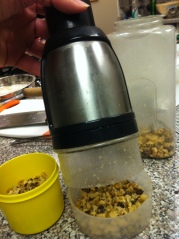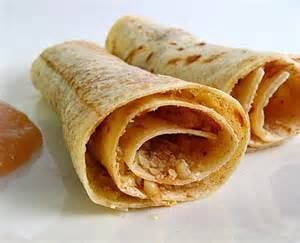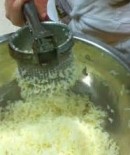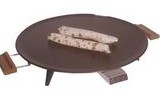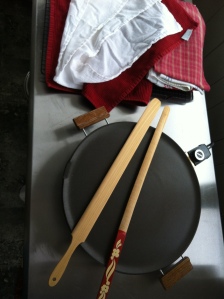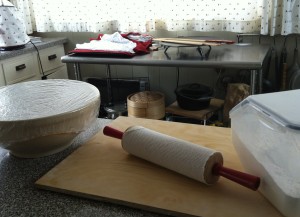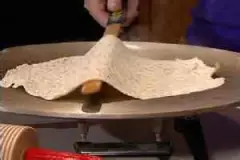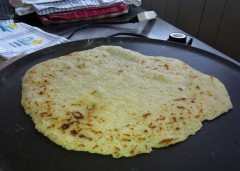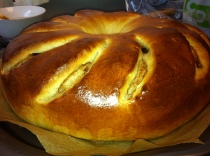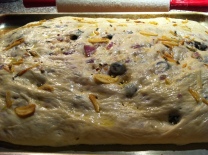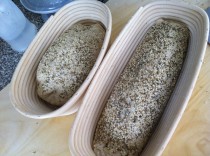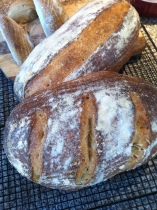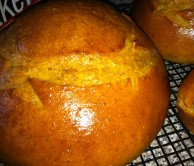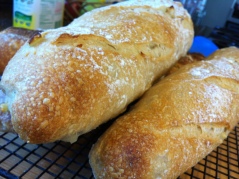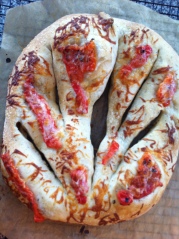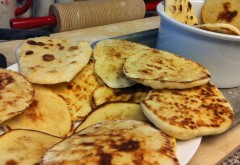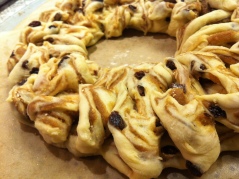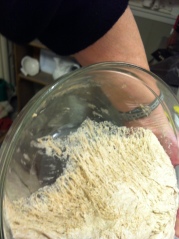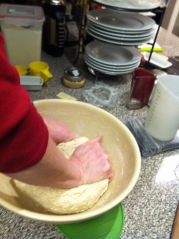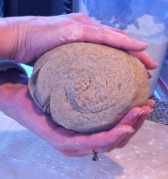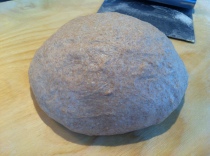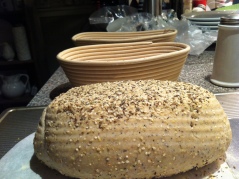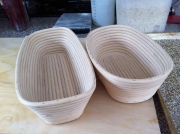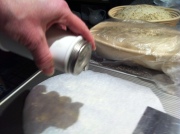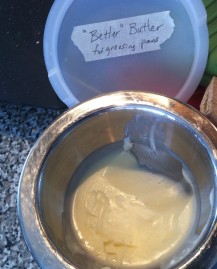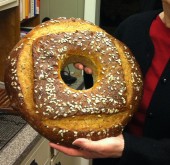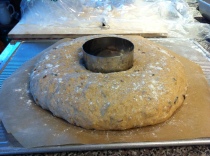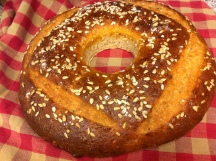Tags
Amaranth, banneton, bench scraper, Better Butter, biga, Buckwheat Groats, delayed fermentation, flax seed meal, flax seeds, how to make bread, Kamut, kneading, proof, Quinoa, Reinhart, rolled oats, soaker, steam in oven, whole grain, whole wheat, Wild Rice
I have been on a struan baking frenzy of late. Other breads have also come out of my kitchen in the past couple of months since I last posted, but the struan has become one of my favorites for many reasons. It is a whole grain bread so that means it is really good for you however is not an especially dense bread. The delayed fermentation method is the reason for that. Also, the flexibility of whole grains that can be included, allows me the satisfaction of altering the flavor just a bit from batch to batch, which I love being able to do. (One of my quirks<—I don’t like to make the exact same bread twice in a row, to which my husband will attest.)
 I am using Peter Reinhart’s formula from his book, Whole Grain Breads and he calls it simply “Multigrain Struan.” I call this recipe “Gaelic” only because struan is a Gaelic word and I like the sound of it. His formula uses the delayed fermentation method which I talked about in a previous post, “Delayed Fermentation Method.” His recipe makes one large loaf. I have re-written it here to make two large loaves, and I will include some of the grain combinations which I have used and can vouch for their excellent flavors and textures. There are dozens more to be tried.
I am using Peter Reinhart’s formula from his book, Whole Grain Breads and he calls it simply “Multigrain Struan.” I call this recipe “Gaelic” only because struan is a Gaelic word and I like the sound of it. His formula uses the delayed fermentation method which I talked about in a previous post, “Delayed Fermentation Method.” His recipe makes one large loaf. I have re-written it here to make two large loaves, and I will include some of the grain combinations which I have used and can vouch for their excellent flavors and textures. There are dozens more to be tried.
GAELIC MULTIGRAIN STRUAN makes 2 large loaves
Struan means “the convergence or confluence of streams” in Gaelic. Reinhart says there is no official recipe for struan. Struan is made using whatever grains are available at harvest time.
*Precook these grains: *May use these grains uncooked:
Barley, buckwheat, bulgar Amaranth, Rolled oats, oat or wheat bran
Couscous, cracked wheat Triticale flakes, multigrain cereal mixes
Grits, millet, quinoa, rice Flaxseeds, and any type of flour or meal
Steel-cut oats, teff
Whole wheat or rye berries
SOAKER
¾ c. + 2T or 113 g. whole wheat flour
2 2/3 c. or 370 g. *any combination of cooked and uncooked grains
1 tsp. or 8 g. kosher sea salt
1 ½ c. or 340 g. milk, buttermilk, soy or rice milk. (I use whole milk)
- Mix all of the soaker ingredients together in a bowl for about 1 minute, until all of the flour is hydrated and the ingredients form a thick, porridge-like dough.
- Cover loosely with plastic wrap and leave at room temperature f
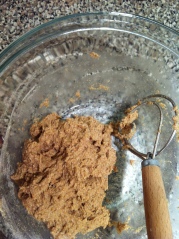 or 12 to 24 hours. (If it will be more than 24 hours, place the soaker in the refrigerator; it will be good for up to 3 days. Remove it 2 hours before mixing the final dough to take off the chill.) I make the soaker and the biga the night before I intend to bake bread.
or 12 to 24 hours. (If it will be more than 24 hours, place the soaker in the refrigerator; it will be good for up to 3 days. Remove it 2 hours before mixing the final dough to take off the chill.) I make the soaker and the biga the night before I intend to bake bread.
BIGA
3 ½ c. or 454 g. whole wheat flour
½ tsp. or 2 g. instant yeast
1 ½ c. or 340 g. spring water, at room temperature (~70 F)
- Mix all of the biga ingredients together in a bowl to form a ball of dough. Using wet hands, knead the dough in the bowl for 2 minutes to be sure all of the ingredients are evenly distributed and the flour is fully hydrated. The dough should feel very tacky. Let the dough rest for 5 minutes, then knead again with wet hands for 1 minute. The dough will become smoother but still be tacky.
- Transfer the dough to a clean bowl, cover tightly with plastic wrap and refrigerate for at least 8 hours and up to 3 days.
- About 2 hours before mixing the final dough, remove the biga from the refrigerator to take off the chill. It will have risen slightly but need not have risen significantly in order to use it in the final dough.
FINAL DOUGH
Use all of the soaker
Use all of the . biga
¾ c. + 2 T. or 113 g. whole wheat flour
1 ¼ tsp. or 10 g. kosher sea salt
4 ½ tsp. or 14 g. instant yeast
6 T. or 113 g. honey or agave nectar
2 T. or 28 g. unsalted butter, melted, or vegetable oil
Extra whole wheat flour for adjustments
- Using a metal bench scraper, chop the soaker and the biga into 16 smaller pieces each (sprinkle some of the extra flour over the pre-doughs to keep the pieces from sticking back to each other).
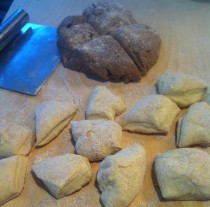
- Combine the soaker and biga pieces in a large bowl with all ofthe other ingredients except the extra flour and knead with wet hands for about 2 minutes, until all of the ingredients are evenly integrated and distributed into the dough. Wet hands make the kneading so much easier. The dough should be soft and slightly sticky; if not, add more flour or water as needed. I have found that when I use a combination of grains which do not need to be pre-cooked, there is little adjustment required. When I use larger kernel grains that need to be precooked, I have more adjustment to make.
- Dust a work surface with flour, then toss the dough in the flour to coat. Knead by hand for 3 to 4 minutes, incorporating only as much extra flour as needed until the dough feels soft and tacky, but not sticky. Form the dough into a ball and let it rest on the work surface for 5 minutes while you prepare a clean, lightly oiled bowl. (I use a 6 qt. rising bin with straight sides and oil it with Better Butter.) You will notice the texture of the dough is softer after the 5 minute rest which seems rather magical to me.
- Resume kneading the dough for 1 minute to strengthen the gluten and make any final flour or water adjustments. The dough should have strength and pass the windowpane test, yet still feel soft, supple and very tacky. Form the dough into a ball and place it in the prepared bowl, rolling to coat with oil. Cover loosely with plastic wrap and let rise at room temperature for approximately 45 to 60 minutes, until it is about 1 ½ or 2 times its original size. The straight side
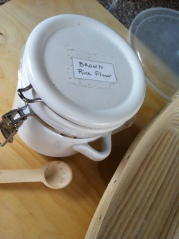 d rising bin is so helpful since I can see more accurately how much the dough has risen.
d rising bin is so helpful since I can see more accurately how much the dough has risen. - Transfer the dough to a lightly floured work surface. Divide dough in half with the metal bench scraper and form each half into either a loaf pan shape or a batard. Place loaf into a greased 4 X 8 ½” bread pan, or place batards on a parchment paper dusted with semolina flour. Mist the top of the loaves with pan spray (optional) or water and sprinkle with poppy seeds or sesame seeds. Cover the loaves loosely with plastic wrap and let rise at room temperature for approximately 45 to 60 minutes, until it is about 1 ½ times its original size. (Alternatively, you may place the loaves in bannetons if you like, for the final rise. Wicker bannetons dusted liberally with brown rice flour will release the risen loaves very nicely.)
- Prepare the oven for hearth baking (unless you are using bread pans) and preheat the oven to 425 F. Place the baking stone on the middle rack with a pan below into which you will put water to introduce steam just before sliding the loaves into the oven. (I will write another post with more detail about introducing steam into the oven.) When I use bannetons for the final rise, I will spray the top of the loaf with water or high heat baking spray immediately after turning the loaves out onto the dusted parchment. Score the loaves using a very sharp serrated knife or lame dipped in water. Place the loaves in the oven, and lower the temperature to 350 F. Bake for 20 minutes. Rotate the loaves 180 degrees and continue baking for another 20 to 30 minutes, until the loaf is a rich brown on all sides, sounds hollow when thumped on the bottom, and registers at least 195 F. in the center.
- Transfer the bread to a cooling rack and allow it to cool for at least 1 hour before slicing.
Here are some of the combinations of grains which I have tried in the struans. We have liked them all so I certainly can’t say which are the tastiest.
1) Quinoa – 170 g.; buckwheat groats – 100 g.; Flaxseed – 30 g.; Wild Rice – 70 g.; and because this turned out to be a very wet soaker, the next day I added 70 g. rolled oats and additional bread flour (rather than whole wheat) to adjust. Very tasty!
2) Kamut – 100 g.; Quinoa – 100 g.; Medium grind corn meal – 100 g.; Flax seeds – 40 g.; Wild rice – 30 g. Excellent flavor! The kamut is a very large kernel and so requires a long time to soften up a bit.
3) Rolled oats – 100 g.; Fine grind 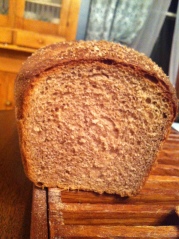 cornmeal – 100 g.; Amaranth – 50 g.; Flax seeds – 50 g.; Flax seed meal – 40 g. Very good! Slight nutty flavor. (This is the only combination I’ve tried that does not have at least one cooked grain in the mix. I think there is something about the addition of a cooked grain which I like very much in the finished product. I decided at this point to always choose at least one grain that is cooked.)
cornmeal – 100 g.; Amaranth – 50 g.; Flax seeds – 50 g.; Flax seed meal – 40 g. Very good! Slight nutty flavor. (This is the only combination I’ve tried that does not have at least one cooked grain in the mix. I think there is something about the addition of a cooked grain which I like very much in the finished product. I decided at this point to always choose at least one grain that is cooked.)
4) Whole wheat berries – 100 g.; Wild rice – 100 g.; Flax seed meal – 40 g.; Medium grind corn meal – 50 g.; Whole grain teff – 40 g.; Amaranth – 40 g. ( I really like the taste of amaranth. That, plus the corn meal produce a satisfying crunchiness. The whole wheat berries should cook until they seem softened, not mushy.)
There are so many more combinations that I want to try. I’d love to hear from others about struans that they have made. Happy baking!

